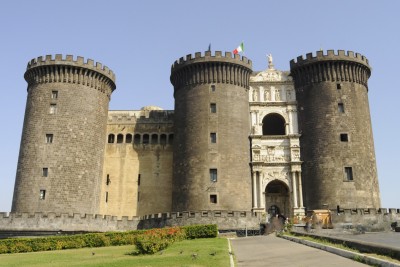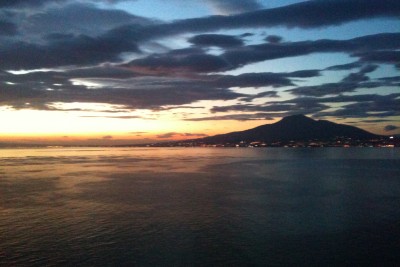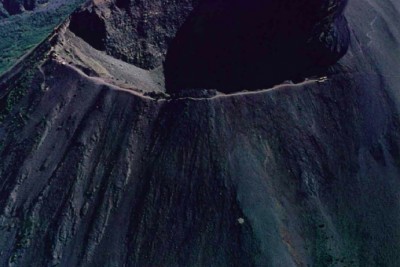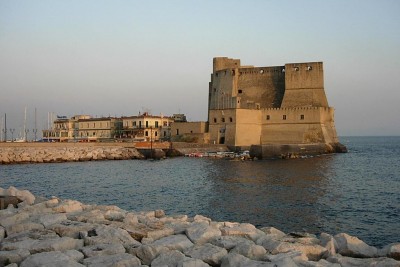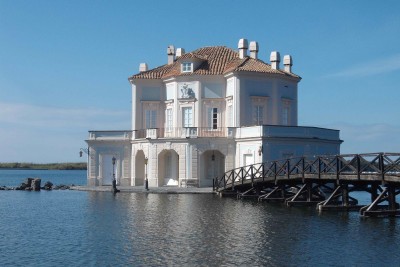Our Insider Guide to Naples - Part 1
Even with all its difficulties and contradictions Naples remains an extraordinary place to visit


The earliest Greek settlements were established in the Naples area in the 2nd millennium before Christ.
In the 9th century B.C., Grek sailors established a small commercial port on the island of Megaride.
In the 6th century B.C. a new urban zone, called Neápolis (Νεά πολις, or new city) was founded on the plain below Mt Vesuvius, It eventually became one of the foremost cities of the so-called Magna Graecia (Greater Greece).
In 326, Naples was declared a Roman colony.
After the fall of the Roman Empire, Naples became the capital of a Duchy that managed to stave off the invading Longobards.
In 1137 the Duchy fell into the hands of the Normans. After the death of Frederick II of Svevia, Carlo d'Angiò made his triumphal entrance to Naples in 1266.
In 1442, after a long war that brought the city to its knees, power then passed into the hands of Alfonso d'Aragona.
Important civil engineering (the construction of sewage conducts, the opening of via Toledo, the construction of the Spanish Quarters - formerly military barracks - and the restoration of the Chiaia Riviera) were undertaken and completed during the following two and half centuries up to the arrival of the Bourbons (1734), who ruled the Kingdom of Naples until 1860, when Italy was finally united.
Our journey of discovery of the city begins in the historic core, which still preserves its ancient Greek-Roman imprints, and continue with the places of power of the medieval-renaissance period, concentrated around the Castel Nuovo and Royal Palace. We will then follow along the waterfront from the Castel dell'Ovo to Posillipo, to end up on the green hills of Capodimonte and Vomero.
From Spaccanapoli to Piazza Mercato
The heart of Naples is the Greco-Roman historical center, a chessboard divided by three main roads, the decumans, intersected at right angles by roads called "cardinals".
It is here that the pulse of the City is best felt: the alleys, the artisan workshops, the innumerable artistic marvels that surprise you in the least expected places, the voices of the "Napolitani".
It is also the cultural center of the City, with the University on via Mezzocannone, the literary cafes of Bellini Square, the bookshops of Port'Aiba, and the Italian Institute for Historical Studies on via Benedetto Croce.
The piazza di the Gesù Nuovo is the entrance gate to the old center. The steeple of the lmmacolata (1747) and the Chiesa del Gesù Nuovo (#1 on the map) introduce baroque religiousness to the city.
 Chiesa del Gesù Nuovo
Chiesa del Gesù Nuovo
The vault has frescoes by Belisario Corenzio and Paolo de Matteis, while the back of the facade has an “Expulsion of Heliodorus from the Temple” painted in 1725 by the baroque master Francesco Solimena.
Around the altar are three bronze bas-reliefs on a black marble base: on the left, The Supper at Emmaus, on the right, The Promise of the Eucharist at Capernaum, and in the middle a Last Supper.
The chapel of the Visitation has an altar-piece by Massimo Stanzione.
At the end of the right aisle, there is the Sacred Heart chapel, with an altar-piece displaying the Virgin with Child Jesus and 3 Saint attributed to Giovanni Bernardino Azzolino (1560–1610).
In the Chapel of St Ignatius of Loyola is a picture of the Holy Trinity with Groups of Saints, by Guercino.
In the Chapel of the Crucifix is a wooden statue of Christ crucified, with the Blessed Virgin and St. John, sculpted by Francesco Mollica, a pupil of Michelangelo Naccherino.
The two imposing side Reliquaries, with 70 busts of saint martyrs in golden wood, were made in the most part in 1617 by the Neapolitan woodcarver Giovan Battista Gallone.
Not far away is the austere Basilica di Santa Chiara (#2), built in 1310 by Roberto d'Angiò in a Provencal gothic style and transformed with baroque decorations in the mid 1700's.
After being damaged by the bombings of 1943, it was restored back to its original, more sober, form. Here you will find the sepulchral monuments of the royal Anjou family (14th century), work of sculptors of the Tuscan school.

Cloister of Santa Chiara
A stroll in the cloisters of the Basilica is not to be missed. Here Naples suddenly becomes silent and perfumed by narcissus and wisteria. Yellow, green and blue are the dominating colors of the tiles that dress the magnificent octagonal columns and the seats on which Donato and Giuseppe Massa painted pastoral and mythological scenes.
In via Benedetto Croce the 14th century Palazzo di Filomarino della Rocca was the home of philosopher Benedetto Croce.
Piazza San Domenico is one of the Aragons' most notable urban legacies, a peaceful co-existence of contrasting architectural styles. First you can appreciate the 13th century Chiesa di San Domenico Maggiore (#3).
 San Domenico Maggiore, interior
San Domenico Maggiore, interior
The official church of the Aragonese dynasty, it was founded by the friars of the Dominican Order who incorporated a smaller, original church built on this site in the 10th century. Charles II, King of Naples, began the rebuilding that produced the new Church of San Domenico Maggiore.
The work was done between 1283 and 1324, but the church has undergone modifications over the centuries.
The monastery annexed to the church was the original seat of the University of Naples.
It is here that Thomas Aquinas, a former member of the Dominican community there, returned to teach theology in 1272.
The sacristy houses a series of sepulchres of members of the royal Aragonese family, including that of King Ferdinand I.
In piazza San Domenico you can also admire the lovely façades of the 18th century Palazzo Corigliano (#4).
 Palazzo Corigliano
Palazzo Corigliano
The palace, originally called "Palazzo Sangro Vietri", was designed in the 16th century by architect Giovanni Francesco Mormando Cosentine, but little or nothing remains of that original building prior to the 1688 earthquake that damaged it, along with other buildings in Naples.
The interior is in the Rococo style. On the second floor, in the reading room of the Library of Asian Studies, you can admire the frescoed ceiling and walls.
Today the palazzo is the seat of the University of Naples prestigious Istituto Orientale, or Oriental Institute.
In piazzetta Nilo stands the Hellenistic statue of Nilo, rediscovered in the middle ages, to which the Neapolitans have given the affectionate name of "Body of Naples". Here the little Chiesa di Sant'Angelo a Nilo (#5) stands.
 Chiesa di Sant'Angelo a Nilo
Chiesa di Sant'Angelo a Nilo
Built in 1385 and altered in the 18th century, it contains the beautiful Renaissance tomb of Cardinal Rinaldo Brancaccio, made in Pisa from 1426 to 1428 by Donatello, Michelozzo and Pagno di Lapo, and sent to Naples by sea.
Strolling along via San Biagio dei Librai (also known as Spaccanapoli) you can browse in the little shops full of antiques, religious objects and jewelry.
At number 114 you come across a masterpiece from the late Mannerism period of the 17th century - the Cappella del Monte di Pietà (#6).

Cappella del Monte di Pietà
Part of the monumental Palazzo Carafa, it was decorated with frescoes by Belisario Corenzio with the help of Luigi Rodriguez and Batistello Caracciolo.
Almost hidden in a tiny alley that intersects with vico San Domenico you find the small but extraordinary Cappella di Sansevero (#7).
 Veiled Christ
Veiled Christ
A visit to this spectacular baroque complex is a must as the statue of the Veiled Christ, by Giuseppe Sanmartino, is a true masterpiece.
Just nearby you will notice the bell tower and the Chiesa di San Gregorio Armeno (#8).

Chiesa di San Gregorio Armeno
In the 8th century, the iconoclast decrees in Greece caused a number of religious orders to flee the Byzantine empire and seek refuge elsewhere.
San Gregorio Armeno in Naples was built in the 10th century over the remains of a Roman temple dedicated to Ceres, by a group of nuns escaping from the Byzantine Empire with the relics of St. Gregory, bishop of Armenia.
The construction of the present day church was begun in 1574 and finished five years later.
The façade has three arcades surmounted by four pilaster strips in Tuscan order.
The interior has a single nave with five side arcades. The decoration, with the exception of the five chapels, was finished by Luca Giordano (also author of the Saints over the windows of the dome) in 1679.
The famous Holy Staircase was used by the nuns during their penitences.
The cupola was painted with a Glory of San Gregorio by Luca Giordano.
The cassettoni ceiling, or framed canvases, depict the Life of the St Gregory the Armenian.
The Idria Chapel houses paintings of the Life of Mary by Paolo De Matteis,. Over the chapel's high altar is a medieval icon, in Byzantine style, of the Madonna dell'Idria.
The cloister, built in 1580, has a marble fountain in the center, with statues of "Christ and the Samaritana" by Matteo Bottiglieri.
In the two months before Christmas San Gregorio Armeno fills up with stands that sell little figurines and decorations for nativity scenes. Apart from the traditional baby Jesus, Mother Mary and father Joseph figures the craftsmen compete with one another to make figurines depicting political and gossip columns’ personalities.
At the end of this street you are in the heart of the Greco-Roman city, the part of town that was the agora and forum. Its center is piazza San Gaetano, with the Chiesa di San Paolo Maggiore (#9).

San Paolo Maggiore
The Baroque style church is located on the site of the 1st-century temple and was built upon its ruins.
The church includes two Corinthian columns from the ancient edifice. They stand in front, linked by a fragile beam projecting from the facade.
The church erected here in the 8th-9th century was dedicated to St. Paul to celebrate a victory in 574 of the Duchy of Naples against the Saracens.
In the early 1580s, general reconstruction of the church began with the erection of the transept and the polygonal apse. This was followed by the nave built by Gian Battista Cavagni.
The aisles, designed by Giovan Giacomo di Conforto date from 1625 onwards.
As the building was proceeding, it was decorated, notably by Massimo Stanzione who painted the nave ceiling with a series of canvases depicting events in the life of St Paul.
The decoration continued in the 18th century with, among others, Domenico Antonio Vaccaro and Francesco Solimena, who re-used marble elements from the ancient edifice for the new pavement and the pilasters of the nave.
The nave has remains of Stanzione's frescoes depicting Histories of Sts. Paul and Peter.
Other frescoes by Francesco Solimena can be seen in the sacristy.
Notable for their marble decorations, are the Chapels of Firrao di Sant'Agata and the Madonna della Purità, both dating from the 17th centuries. The main altar was sculpted in 1775-1776 to a design by Ferdinando Fuga.
The cloister was built in the late 16th century, and occupies the area of the former pagan temple using columns taken from the former Palaeo-Christian church.
At the precise geographic center of the ancient Greek-Roman city, stands the Chiesa di San Lorenzo Maggiore (#10).
 Chiostro of San Lorenzo Maggiore
Chiostro of San Lorenzo Maggiore
Right beneath the church was an ancient Roman market, which has been excavated and is now the only large-scale Greek-Roman site visible in the downtown area.
The cupola of the Cacace Chapel was frescoed by Niccolò De Simone, who finished the job of the prior artist, Massimo Stanzione. It depicts the “Trinity and Glory of the Virgin”, though the fresco is severely damaged and hardly visible nowadays.
The altarpiece, painted by Massimo Stanzione, depicts the “Our Lady of the Rosary”, a subject that became popular after the Council of Trent of 1563.
Stanzione’s style is reminiscent of Caravaggio, though with brighter use of color. In the cloister of the church is where writer Giovanni Boccaccio met his darling Fiammetta in 1336.
A trip in the underground of Naples is an exciting experience that would reveal the history and legends of the city. No one knows the exact dimensions of the "dark" Naples, but speleologists have counted up to 700 cavities for a total area of 1 million metric cubes.
A two-hour time travel trip begins in piazza San Gaetano, in the heart of the historical center.
The Greek-roman theater has a picturesque low entrance in Cinquesanti alley. From the cloister of the San Lorenzo Maggiore church it is just a few paces to step backwards 2,600 years among the stones of the Greek walls.
In the Spanish Quarters the descent is to 40 mts below the ground along stairs that lead to the ancient cisterns and aqueducts (which were used as shelters from the bombing during the World War II).
In via Tribunali, to the left, the little Chiesa di Santa Maria del Purgatorio ad Arco (#11) is characterized by a bizarre baroque decoration of skull and bones (in front of the church).
 Chiesa di di Santa Maria del Purgatorio ad Arco
Chiesa di di Santa Maria del Purgatorio ad Arco
It symbolize the devotion of the Neapolitans to the "pained souls", known as "pezzentelle", a slang for "without relatives".
The church, commissioned by several aristocratic families in Naples, was built in 1616.
The portal and the tondo above the relief of the “Madonna with the Souls of Purgatory” were made in the early 18th century by sculptor Giuseppe de Marino.
The interior has a nave with side chapels.
The sanctuary and the apse were decorated by Dionisio Lazzari in 1669.
Behind the 18th-century altar, preceded by a marble balustrade, there is an altarpiece of the “Madonna of the Souls in Purgatory” painted by Massimo Stanzione between 1638 and 1642.
The canvas, clearly inspired by Caravaggio, has a marble frame decorated with winged skulls.
Just a little ways on is the Chiesa di San Pietro a Majella (#12), home to one of the most important conservatories of music.
 Chiesa di San Pietro a Majella
Chiesa di San Pietro a Majella
The church is considered one of the most significant examples of Angevin architecture in Naples and was built in the early 14th century at the wishes of Giovanni Pippino da Barletta, one of the knights of King Charles II of Anjou.
It was named for and dedicated to Pietro Angeleri da Morone, a hermit monk from Maiella, who became Pope Celestine V in 1294. He was the founder of the Celestine monastic order, which occupied the church until 1799, when monasteries were suppressed by the Neapolitan Republic.
San Pietro a Majella underwent a Baroque make-over by the Spanish in the 17th century, although a 20th-century restoration partially restored its original Gothic appearance.
The interior has three naves, separated by pillars supporting Gothic arches, with nine lateral chapels, plus four on each side of the chancel, and transept. The 14th century tomb of Pepino di Barletta, architect of the church, is placed on the counter-façade.
The main 17th century altar, with large vases and candlesticks in silver, is preceded by a balustrade covered in polychrome marbles. A 15th-century wooden crucifix stands on it, while behind there are 17th century frescoes and 16th century sculptures.
The ceiling of the nave and the transept feature paintings by Mattia Preti depicting Episodes from the life of St. Peter Celestine and Saint Catherine of Alexandria (1657-1659).
The first chapel on left has majolica tiles with designs typical of Aragon.
The transept, second to the left of the apse chapel, has a majolica tiled floor and Giottesque frescoes depicting ‘’Stories of Mary Magdalene’’.
On the fourth chapel on right there is a painting of the Madonna appearing to St Peter Celestine, by Massimo Stanzione.
The nearby piazza Bellini is very lively, especially in the evenings, and full of cafes. In the opposite direction, towards the end of via Tribunali, you will find the Chiesa dei Girolamini (#13).
 Chiesa dei Girolamini
Chiesa dei Girolamini
The first cloister, known as "chiostro maiolicato" for its embedded maiolica, is on the site of an earlier building, the Palazzo Seripando, which was bought in 1586. The palazzo was demolished and construction started on the new structure in 1592 on plans by the Florentine architect Giovanni Antonio Dosio.
The much larger second cloister, dating from the 17th century, is reached from the first; in it are found the entrances to both the "Quadreria" or art collection, previously housed in the sacristy of the Church, and the magnificent library of the Oratorian Fathers, the Biblioteca Girolamini, now run by the Italian state.
Completed in 1619, the church is also the work of Dosio as well as that of Nencioni and is in the style of the Florentine Renaissance: a Latin cross with three naves supported by arcuated colonnades and with lateral chapels.
The Church and the convent gallery contain works by Luca Giordano, José de Ribera, Guido Reni, Francesco Solimena, Sassoferrato, Andrea Sabbatini, Francanzano, Beinaschi, and other artists.
The counterfacade has a Giordano painting of Jesus ejecting the moneylenders from the Temple.
The fist chapel on the right has an altarpiece depicting Ss. Giorgio e Pantaleone by Gaetano Pandolfi of Bologna.
The paintings in the third chapel are by Luca Giordano.
The fourth chapel on the right has a painting of St Agnese, by Cristoforo Roncalli , known as il Pomarancio.
The fifth chapel has a St Francis of Assisi by Guido Reni.
From the right transept you can enter the Sacristy where you will find a series of painting including a St. Francis in Ecstasy (1622) and Jesus meets St. John the Baptist (1622) by Guido Reni, and a St. Nicholas of Bari saves three children from a vat, San Carlo Borromeo kisses the hand of St Phillip Neri, St. Charles Borromeo and St. Philip Neri by Luca Giordano.
Via Tribunali intersects with via Duomo, which in turn takes its name from the Duomo, or Cathedral of Naples (#14), a gothic structure completed by Robert of Anjou in 1313.

The façade has been renovated, as the original one collapsed in the 1349 earthquake.
Inside, the structure has three naves and is richly decorated. You can clearly see the 18th century baroque interventions on the central nave. Along the left nave is the entranceway to the paleo-Christian basilica of Santa Restituita.
Founded in the 4th century by the Emperor Constantine, today it reveals a Baroque interior created after the 1688 earthquake.
The ample fragments of mosaic pavement seem to belong to yet another paleo-Christian basilica, Stefania (6th century).
Under Santa Restituita you can see Greek-Roman archaeological remains.
On the left of the apse is the entrance to the Battistero di San Giovanni in fonte, built between the 4th and 5th century, and therefore the oldest building of its kind in the Christian world. On the square structure rests a mosaic-covered dome. Other than the medieval chapels, rich with frescoes and decor, the 17th century Cappella del Tesoro di San Gennaro, the Chapel of the Treasure of St Gennaro, is also of interest.
 Chapel of the Teasure of San Gennaro
Chapel of the Teasure of San Gennaro
For its embellishments the king summoned the most famous painters of the period (Fanzago, Domenichino, Ribera, Lanfranco).
The magnificent chapel is highlighted by the precious decorations and large silver reliquery busts.
It is here that for the two weeks of celebration of the miracle of the liquefaction of San Gennaro's blood the reliquary is on exhibit.
At number 288 of via Duomo is the Museo Civico Filangieri (#15).

Museo Civico Filangieri, "Head of St. John the Baptist" by Jusepe de Ribera.
The museum is housed in the Palazzo Cuomo, whichl was built in a Renaissance style, with an ashlar stone facade, between 1464 to 1490 by merchant Angelo Como (or Cuomo). The architect was the Florentine Giuliano da Maiano.
It was sold in 1587 and was incorporated into an adjacent monastery.
In 1881-82, during an urban renewal of Naples, the building was dismantled and moved back some 20 meters to widen the street.
The museum was inaugurated in 1888 by Gaetano Filangieri, princie of Satriano.
The collection is composed of a different art objects – armaments, porcelain, books and furniture. Among the artists are Jusepe de Ribera, Bernardino Luini, Francesco Solimena and Luca della Robbia
Going up past the Duomo, to the right, on a cross street, is the Donna Regina Palace. This is where MADRE Museo d'Arte Contemporanea Donnaregina, the Contemporary Art Museum (#16) has its seat.

The building was designed by Portoguese architect Alvaro Siza
It hosts works that were once shown in piazza del Plebiscito and the Archaeological Museum, as well as works conceived, projected, painted or built expressly for this museum: important works of such artists as Long, Bianchi, Clemente, Horn, Kapoor, Kounellis, Paolini, Sol Lewitt, Serra, and others.
Cross via Duomo and, on the right, on via dei Tribunali is the Complesso del Pio Monte della Misericordia (#17), founded in 1601.
 Pio Monte della Misericordia
Pio Monte della Misericordia
It is on of the city's oldest charitable organization, founded in August 1601 by seven young nobles.
In 1602 they established an institution and commissioned a small church, built by Gian Giacomo di Conforto, near the staircase leading to the Cathedral.
The church was consecrated in September 1606.
In the second half of the 17th century the edifice was enlarged with the annexation of neighboring structures, forming a complex with a palace and a renewed church.
The main altar of the church houses Seven Works of Mercy, painted by Caravaggio in 1606 and 1607. There are also paintings by Luca Giordano, Carlo Sellitto, Fabrizio Santafede, Battistello Caracciolo and others.
At the end of via dei Tribunali you are in front of Castel Capuano (#18), the oldest of Naples’ four castles.
 Castel Capuano
Castel Capuano
Built in the Norman era, it became the Palace of Justice and is today the seat of the Civil Court. One of the gates of Naples is also here, Porta Capuana. Erected in 1484 it was the most important eastern entrance to the city.
Here, and near Porta Nolana, by the train station in Garibaldi Square, there are two of the most picturesque of the city's markets, specializing in fish, fruit and vegetables.
Not far away is the Chiesa di San Giovanni a Carbonara (#19).
 Chiesa di San Giovanni a Carbonara
Chiesa di San Giovanni a Carbonara
The complex of San Giovanni was founded by the Augustinians in 1343.
The church was completed in the early 15th century under King Ladislaus of Durazzo, who turned the church into a Pantheon-like tribute to the last of the Angevin rulers of Naples.
The façade, with its scenographic stairwell entrance was built in 1707 or 1708 by Ferdinando Sanfelice.
It maintains the Gothic portal with a lunette frescoed by the Lombard Leonardo da Besozzo.
The interior is on the Latin Cross plan, with a rectangular nave.
The main altar decorated with polychrome marble dates from 1746.
The Caracciolo del Sole, near the apse, is a Renaissance style chapel with frescoes by Perinetto and Leonardo da Besozzo.
The Seripando Chapel, or Capella del Crocifisso, houses a Crucifixion by Giorgio Vasari.
The last stop is piazza Mercato (#20), one of the crucial corners of Neapolitan history.

Piazza del Mercato in an old print
In this square Konradin, the last Hohenstaufen heir to the throne of the kingdom of Naples, was beheaded in 1268 at the hands of Charles I of Anjou, thus beginning the Angevin reign of the kingdom.
In 1647 Neapolitan popular hero Masaniello also gathered his people here during the anti-Spanish revolt he led.
In 1799, the piazza was the scene of the mass execution of leaders of the Neapolitan Republic.
The square is dominated by one of the most popular and venerated churches of all of Naples, the Basilica di Santa Maria del Carmine (#21).
 Basilica di Santa Maria del Carmine Maggiore
Basilica di Santa Maria del Carmine Maggiore
The church was founded in the 13th century by Carmelite friars driven from the Holy Land in the Crusades, presumably arriving in the Bay of Naples aboard Amalfitan ships.
Some sources, however, place the original refugees from Mount Carmel as early as the eighth century.
The church is home to two renowned religious relics: the first one, a painting of the so-called "Brown Madonna", or Madonna Bruna, is said to have been brought by the original Carmelites; the second is a figure of the Crucifixion in which the crown of thorns is missing.
According to legend, the crown fell off as Christ's head moved when the building was struck by a cannonball in 1439 during the Aragonese siege.
The elaborate Baroque decoration in the interior include stucco, carved wood, and polychrome marble.
Beside a funeral monument to Conradin of Swabia, the church has altarpieces by Mattia Preti, Giovanni Sarnelli and Francesco Solimena.
The Chapel of the Virgin del Carmelo, has a 12th century icon of the Virgin and child.
In July, a fireworks competition is held that concludes with the burning of the highest bell tower of the City (75 meters).
Finally, on via Nuova Marina, you will find the Port of Naples (#22).
 Port of Naples
Port of Naples
It was begun by Charles II with the Angioino Pier, and enlarged in the course of the centuries until the early 1900's, when it reached its present day dimensions.
For printing our entire Naples Guide (facing pages) you can download the PDF by clicking HERE
For offline reading on your smartphone or tablet, you can download the PDF of our entire Naples Guide (single page) by clicking HERE. If you have an Android OS, you will find it in your Download app. If you have an iPhone or an iPad, open and save it in iBook (free app).
Watch a video on Naples

